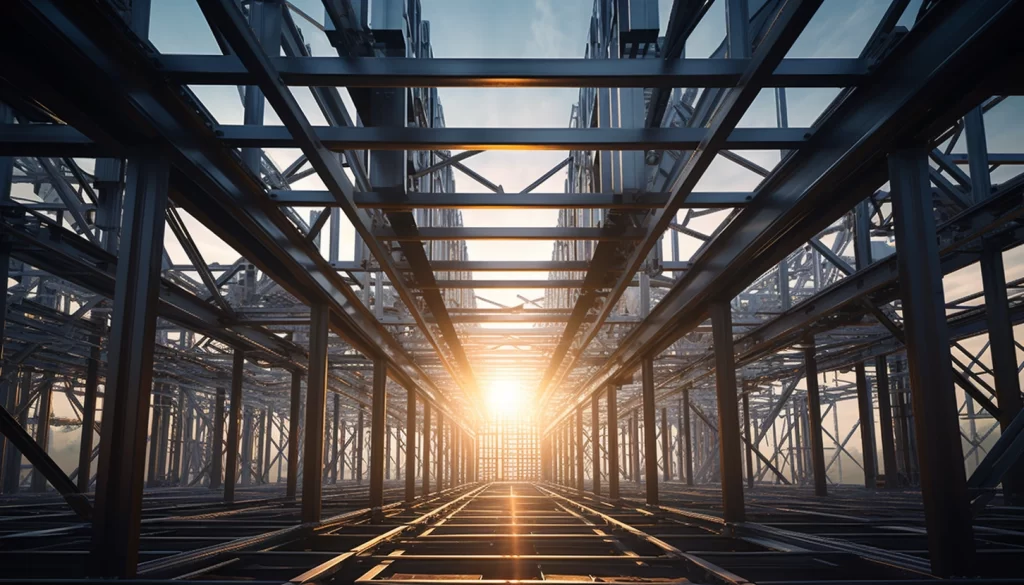When it comes to construction and infrastructure projects, material choice significantly affects the efficiency, cost-effectiveness, and sustainability of the build. As the search for more resilient and economical materials continues, high-strength steel alloys have emerged as a viable contender. These unique materials offer substantial benefits that enhance the efficiency and durability of construction projects.
High-strength steel alloys refer to a class of steel characterized by enhanced strength, durability, and resistance to adverse conditions. They contain different alloying elements, such as carbon, manganese, and silicon, contributing to their high yield strength. The strength-to-weight ratio of these steel alloys is far superior compared to traditional construction materials like concrete and wood.
Evolution and Advancements in High-Strength Steel Alloys

High-strength steel alloys have evolved significantly to meet construction and infrastructure demands. Advanced manufacturing has enabled the production of these alloys with superior properties, including better yield strength, enhanced ductility, and increased corrosion resistance.
Nanotechnology breakthroughs have led to nanostructured steel, characterized by fine grain structure, offering exceptional strength and hardness, ideal for high-performance construction applications. Additionally, heat treatment methods like quenching and tempering have been used to improve the hardness and strength of steel alloys, boosting their resistance to wear and tear and enhancing longevity.
High-Strength Steel Alloys vs Traditional Materials in Infrastructure
As our global infrastructure continues to expand and evolve, the choice of materials used in construction has never been more critical. Traditional materials such as concrete and regular steel have long been the foundation of infrastructure projects, owing to their relative availability, ease of use, and established performance. However, in the face of today’s increasing demand for durable, efficient, and environmentally friendly structures, high-strength steel alloys are emerging as a powerful alternative.
High-strength steel alloys offer several advantages over traditional materials. In terms of strength and durability, these advanced alloys significantly outperform regular steel and concrete, being able to withstand higher loads and resist degradation over time more effectively. They allow for more streamlined designs due to their high strength-to-weight ratio, leading to a reduction in the overall mass of the structures. Furthermore, high-strength steel alloys have been associated with improved sustainability. The enhanced longevity of these materials translates into less frequent replacements and repairs, reducing the long-term environmental impact. Also, the steelmaking industry has made considerable strides in minimizing its carbon footprint, making high-strength steel alloys a more environmentally conscious choice.
Impact of High-Strength Steel Alloys on Infrastructure Longevity
In the realm of infrastructure development, longevity is a crucial consideration. The lifespan of a structure directly impacts its overall cost-effectiveness, environmental footprint, and the safety of its users. Herein lies one of the most significant advantages of high-strength steel alloys: their potential to substantially extend the life of infrastructure.
High-strength steel alloys are uniquely engineered to provide superior durability and resistance to wear and tear compared to traditional building materials. Their exceptional strength-to-weight ratio allows for structures that can bear heavier loads and withstand harsh conditions, leading to fewer instances of structural failure over time. The inherent corrosion resistance of these alloys further adds to their longevity, as they can better resist the damaging effects of moisture, air, and chemical exposure. Furthermore, high-strength steel alloys often require less maintenance, reducing the frequency and cost of repairs. This longevity factor not only translates into significant cost savings in the long term but also promotes sustainable practices by decreasing the demand for resource-intensive repairs and replacements, thus minimizing the environmental impact of infrastructure projects.
Benefits of Steel Alloys in Construction
The use of high-strength steel alloys in construction projects offers numerous benefits.
- Strength and Durability: Their high yield strength makes them suitable for building robust structures that can withstand heavy loads and adverse weather conditions. Additionally, the resilience of these materials helps prolong the lifespan of the buildings, reducing the need for frequent maintenance.
- Design Flexibility: The ductility of high-strength steel alloys allows for more intricate and innovative designs without compromising on structural integrity. This flexibility opens up new possibilities in architectural design.
- Cost-Effectiveness: Although the initial investment may be higher, the long-term savings offered by the durability and low maintenance needs of these materials make them a cost-effective choice for construction projects.
- Sustainability: Steel is 100% recyclable, making it an eco-friendly choice for construction. The recycling process does not degrade the quality of the steel, allowing it to be used repeatedly.
Sustainability and Environmental Impact of Steel Alloys in Construction
In contemporary construction and infrastructure undertakings, the sustainability of employed materials has risen to be a central concern. Among various options, high-strength steel alloys stand out for their substantial environmental benefits.
One of the primary ecological advantages of high-strength steel alloys is their recyclability. Steel holds the title of being the most recycled material globally, boasting a nearly 100% recycling rate. Unlike other materials that suffer a downgrade in quality with each recycling cycle, the integrity of steel remains unscathed, even after repeated recycling. This remarkable feature allows it to be reused in new construction projects over and over again, thereby contributing significantly to the circular economy in the construction sector.
Energy efficiency is another cornerstone of the environmental merits of high-strength steel alloys. The manufacturing processes of these alloys have undergone significant transformations, becoming more energy-efficient and contributing to a reduction in greenhouse gas emissions. Furthermore, the integration of high-strength steel in buildings enhances the structures’ energy efficiency. These alloys possess exceptional thermal properties that can lead to significant energy savings, particularly in regulating the heating and cooling needs of a building, further consolidating their role as a sustainable choice in modern construction.
Leading Companies in the High-Strength Steel Alloys Industry
The high-strength steel alloys market comprises several key players that drive industry trends and innovations. Here are a few noteworthy companies that have made significant strides in this sector.
ArcelorMittal
ArcelorMittal, headquartered in Luxembourg, is one of the world’s leading steel and mining companies. With operations in 60 countries, it is known for its quality, innovation, and comprehensive portfolio of high-strength steel products. In recent developments, the company has announced a partnership with Nippon Steel to expand their production of high-strength steel alloys to meet increasing demand. The latest financial report of ArcelorMittal for Q1 2023 showed sales of $18.501 billion with a net profit of $1.096 billion, indicating a strong position in the market.
United States Steel Corporation
United States Steel Corporation, or U.S. Steel, is an American integrated steel producer headquartered in Pittsburgh, Pennsylvania. The company has been at the forefront of advanced high-strength steel (AHSS) manufacturing. They recently launched a new range of high-strength, low-alloy (HSLA) steel products, bolstering their position in the market. In the first quarter of 2023, U.S. Steel reported a net sale of $4,470 million.
SSAB
SSAB is a Swedish company specializing in heavy plate and high-strength steel strip products. Known for its innovation and sustainability efforts, SSAB has made significant contributions to the development of high-strength steel. Their HYBRIT project, aimed at creating fossil-free steel, has recently grabbed headlines and signifies their commitment to sustainable steel production. The company reported Operating result in Q1 of 2023, with an operating profit of SEK 4,733 million.
In terms of competitive analysis, these companies continue to innovate and expand their high-strength steel product lines, driven by the growing demand from the construction and infrastructure sectors. ArcelorMittal’s recent partnership with Nippon Steel, U.S. Steel’s new HSLA range, and SSAB’s groundbreaking HYBRIT project all point towards a highly competitive and dynamic industry landscape.
Future Trends in High-Strength Steel Alloys Use
The future of construction and infrastructure projects looks bright with the increased adoption of high-strength steel alloys. As architectural designs become more complex and environmental regulations stricter, high-strength steel alloys will continue to be a preferred choice. The advancements in steel alloy technology and the increased focus on sustainable construction practices are set to propel the high-strength steel alloys market into new heights.
The high-strength steel alloys market is witnessing a remarkable surge, underpinned by their extensive benefits in construction and infrastructure projects. These materials offer enhanced strength, durability, design flexibility, and significant cost-effectiveness and sustainability aspects. With market research predicting a robust growth trajectory and ongoing advancements in steel alloy technology, the utilization of high-strength steel alloys is poised to reshape the future of the construction industry.
